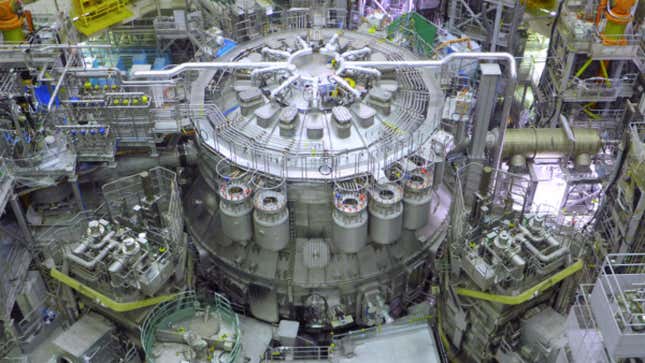
The biggest experimental nuclear fusion reactor in operation was inaugurated north of Tokyo today, as scientists continue to plug away at making nuclear fusion a viable source of the world’s energy.
The reactor—JT-60SA—is a tokamak, a doughnut-shaped reactor that can heat plasma to 360 million degrees Fahrenheit (200 million degrees Celsius). The reactor fired up for the first time in October; at the time, researchers affiliated with the project estimated that it will take two years for the reactor to produce the plasmas necessary for experiments, according to the publication Science.
JT-60SA is “the most advanced tokamak in the world,” EU energy commissioner Kadri Simson said in an inauguration ceremony for the reactor, AFP reported. “Fusion has the potential to become a key component for energy mix in the second half of this century.”
The key word there, obviously, is “potential.” Nuclear fusion is the reaction that powers our Sun and other stars, and while it’s capable of generating huge amounts of energy, scientists have yet to make the process energy efficient on Earth. Nuclear fusion is often referred to as the holy grail of energy research, because if economical fusion reactions were realized it would greatly reduce—if altogether eliminate—humankind’s reliance on fossil fuels.
But that’s a lot easier said than done. The new reactor, along with its counterpart currently under construction in Europe, the International Thermonuclear Experimental Reactor (ITER), are merely experiments to prove the technological feasibility of fusion at scale. ITER is notoriously behind schedule and over budget, and would not prove the economic viability of fusion. It’s best not to put the cart before the horse, but both economic and technological needs will need to be met for fusion to be the energy source many hope it will be.
Nuclear fusion can be done in different ways, but it is regardless a much cleaner process than nuclear fission. Fusion is a thermonuclear reaction that causes two light atomic nuclei to fuse into a heavier nucleus, producing huge amounts of energy in the process. Nuclear fission happens by splitting a large atom into smaller particles; it produces less energy than fusion reactions and produces radioactive material as a waste product, while fusion does not.

Last year, scientists at Lawrence Livermore National Laboratory achieved net energy gain in a fusion reaction, meaning the reaction produced more energy (3 megajoules) than it took to power the reaction in the first place (2 megajoules). It was a significant achievement, but required a far more tremendous amount of energy to power (300 megajoules); in other words, despite the sensational flurry that every bit of progress on fusion causes, there’s a long road ahead.
The fusion experiments that take place in JT-60SA will inform the science that will eventually happen in ITER, a reactor that can hold six times the volume of its Japanese partner. However, JT-60SA will not use tritium—a rare isotope of hydrogen—in its reactions, while ITER plans to start using it in 2035, according to Science.
Nevertheless, JT-60SA will “bring us closer to fusion energy,” Sam Davis, the reactor’s deputy project leader, said in the inauguration. “It’s the result of a collaboration between more than 500 scientists and engineers and more than 70 companies throughout Europe and Japan.”
While large collaborations are working on large tokamaks and stellarators, projects like the MIT-CFS collaboration’s SPARC experiment are building smaller reactors that make use of high-temperature superconducting magnets. SPARC is expected to be completed in 2025, the same year ITER’s first plasma is (currently) expected.
The running joke about scalable nuclear fusion is that it is always just over the horizon—maybe 30, 50 years from now. This timeline is fanciful, but it can never be a reality without work being done towards that end now. So fingers crossed and hats off to you, JT-60SA. Make your run be a fruitful one.